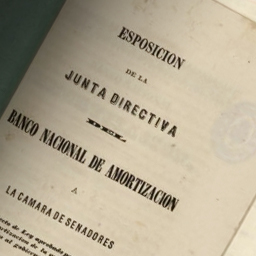Archival Guide
This text is part of a project in process for the preparation of a guide to banking archives in Latin America and Spain. Dr. Carlos Marichal Salinas, professor-researcher of the College of Mexico, invites interested colleagues to collaborate in this section so that together we can build a useful repository on the fundamental primary sources for Ibero-American banking and financial history.
Historical archives of Argentina, Brazil and Mexico
 BANKING HISTORICAL ARCHIVES are an invaluable source for the reconstruction of their history but they are not sufficiently appreciated, neither by the economists nor by the bankers themselves. However, we offer below a tight summary of some of the most important historical archives of banking in Argentina, Brazil and Mexico. For more complete information, including references to other countries and sources of banking history in the United States and Europe, see Carlos Marichal, “Banking History and Archives in Latin America,” Business History Review, vol. 82. Harvard University, 2008, pp. 585-602.
BANKING HISTORICAL ARCHIVES are an invaluable source for the reconstruction of their history but they are not sufficiently appreciated, neither by the economists nor by the bankers themselves. However, we offer below a tight summary of some of the most important historical archives of banking in Argentina, Brazil and Mexico. For more complete information, including references to other countries and sources of banking history in the United States and Europe, see Carlos Marichal, “Banking History and Archives in Latin America,” Business History Review, vol. 82. Harvard University, 2008, pp. 585-602.
In the case of Argentina, the most important and long-lived historical archive belongs to the Bank of the Province of Buenos Aires. The documents are kept in the three floors of the basement below the numismatic museum that the bank maintains in the center of the city of Buenos Aires. The researchers are treated well by the small team of officials who oversee what represents a true treasure of documents dating from 1822. The bulk of the documents belongs to the period from 1860 to 1960 and includes the reports of the boards of the directors, a vast amount of banking correspondence with clients and local banking officers, accounting records, information on mortgages, deposits, loans, and so on. The abundant and well-preserved documents are an extraordinary but still insufficiently used source of information for economic and financial historians. An academic who is an expert in this archive, the historian Gerardo Martí, has written an article summarizing the documentary possessions of the bank “The Archive of the Bank of the Province of Buenos Aires,” Revista de Historia Económica de América Latina, nº 3 , 1995, pp. 29 -37. For more information you should consult the website of the Archive and Museum of the Bank of the Province of Buenos Aires: http://www.bapro.com.ar/museo/index2.htm
For its part, the Banco de la Nación de Argentina does not have a historical archive but its documents are managed by the staff of a small numismatic museum in the central offices of the bank in Buenos Aires. A few years ago, I visited the museum on the top floor of this building on a corner of the Plaza de Mayo, next to the Casa Rosada, the presidential mansion. There I was able to consult a considerable range of documents including minutes of the board of directors of the old National Bank (1872-1890), although, apparently, most of the documents of its branches were destroyed a decade ago. Among the documentary collections kept by Banco de la Nación is a large quantity of materials from this great financial institution after 1891 that have been useful for leading economic historians such as Jeremy Adelman and Gerardo della Paolera to reconstruct important chapters of economic history and financial of Argentina.
The two aforementioned banks promoted the creation of two large mortgage banks: the Mortgage Bank of the Province of Buenos Aires (1872) and the National Mortgage Bank (1886): the first sank with the crisis of 1890, while the second has continued to operate to this day, but with very substantial changes. The documentary collections of Banco Hipotecario Nacional are kept in the offices of the National History Academy. On the other hand, an important part of the documentary collections of what the great rival institution, Banco Hipotecario of the Province of Buenos Aires, are also conserved and can be consulted in the Archive of the Province of Buenos Aires in the city of La Plata.
Mauá’s papers from this collection are conserved in the Institute of Geography and History of Brazil, which also contains particular files of interest for the economic and business history of Brazil. In turn, it should be noted that the economic and business history magazine of the Brazilian Association of Economic History offers additional information on financial resources in Brazilian archives.
& nbsp;

